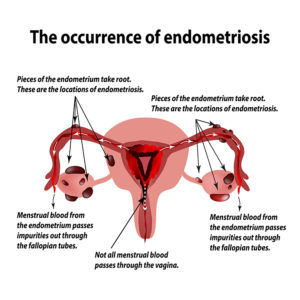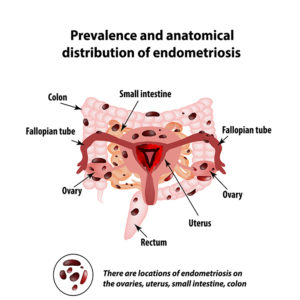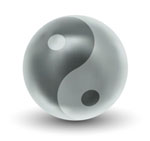Consistent research results show that acupuncture and herbs used in Traditional Chinese Medicine (TCM) are effective treatment for endometriosis. Global bodies such as the United Nations’ World Health Organization (WHO) as well as the leading medical organizations and publications have increasingly approved acupuncture treatment for myriad physical, emotional and mental conditions, as cited by Cohen & Garcia (2013). Indeed, there’s hardly any other treatment as safe and effective as acupuncture and TCM in healing gynecological conditions or reproductive health issues such as endometriosis, infertility and menopausal symptoms.
Endometriosis is confusing and frustrating for sufferers and medics alike since it is largely not well-understood. Also, the modes of treatment for endometriosis available in Western medical settings are usually invasive, they cause unsightly side effects and are only partly effective. This necessitates alternative effective treatment that has no side effects, like acupuncture. First, let us understand endometriosis.
What is endometriosis?

According to Dille & Olive (2004) and Rose (2005) endometriosis refers to a condition whereby the endometrium, also known as the uterine lining, grows in other parts of the body apart from the uterus (where it grows normally). Endometrium is the tissue that develops in every menstrual cycle on the inside walls of the uterus and sheds as blood during menstruation, and this is a normal process that turns into an ailment if the endometrium grows anywhere else other than the uterus. The endometrium is found to have grown at the pelvic organs, around the ovary and in the fallopian tubes in many cases of endometriosis. The tissue still responds to hormonal changes of the menstrual cycle and during a woman’s periods, the blood that usually leaves the body is stuck. This typically results to excruciating menstrual pain, excessive bleeding and infertility.
Epidemiology of endometriosis
Strikingly, the prevalence of endometriosis is relatively high and affects approximately 10 percent of all women in the reproductive age bracket (Cramer & Missmer, 2002). It is strongly linked to infertility because as many as 50 percent of all women experiencing problems conceiving have endometriosis. Endometriosis is far more common in women in their late 30s and 40s as well as those who have never conceived (Eskenazi & Warner, 1997). Considering its relatively high incidence rate as well as the significant health issues it causes such as infertility and agonizing pain, endometriosis presents a momentous public health concern.
According to an article published in the American Journal of Obstetrics and Gynecology, the majority of hysterectomy (surgical uterus removal) cases in the United States are caused by endometriosis and it is also one of the biggest causes of hospitalizations among gynecological conditions (Wilcox et al, 1994). Endometriosis results in significant loss of work hours as many women are rendered powerless to carry on with their duties if they’re experiencing severe symptoms of the condition (Lockhat et al, 2005). Clearly, apart from negatively impacting on a woman’s quality of life and requiring expensive medical care, endometriosis also has a significant economic effect at the workplace.
Signs and symptoms of endometriosis

It is possible to have endometriosis without showing any symptoms (Matorras et al, 1996). However, the commonest symptom is pain at the pelvic area. Cramping and aching normally happen immediately before and in the course of menstruation. The severity of pain do not always point to the magnitude of the condition since some women experiencing great levels of pain may only have slight endometriosis while others having trivial pelvic pain may have serious endometriosis. In many cases, endometriosis is diagnosed when one undergoes an infertility check.
Conventional Treatments for Endometriosis
Current treatments for endometriosis in a Western medical setting involve the administration of NSAID drugs for relieving pain and managing inflammations as well as surgery (Schriock et al, 1985). Undeniably, these treatments do not address the actual cause of the condition but only cover the symptoms. Hormone therapy is at times prescribed whereby the patient is given oral contraceptives or pills for managing progesterone or gonadotropin and androgenic boosters. However, as nearly every woman with endometriosis would attest, managing pain is usually not enough. Also, side effects of the pills administered for endometriosis include remarkable reduction of libido and suppression of menstruation as well as ovulation.
The surgical operation of hysterectomy means that the uterus is removed and thus the woman is rendered barren, and the symptoms of endometriosis may still reappear after hysterectomy (Matorras et al, 2012). However, the majority of women with endometriosis would love to bear children. In fact, numerous cases of endometriosis are realized only when undergoing infertility treatment. Thus, an alternative treatment for endometriosis is necessary in sidestepping the negative consequences of the conventional treatments. Enter acupuncture and Traditional Chinese Medicine…
Acupuncture as a viable alternative treatment for endometriosis
With over 2,500 years of practice, acupuncture is a safe and powerful regimen that remarkably relieves pain, bleeding as well as infertility which results from endometriosis. Acupuncture and TCM treatment in general is largely non-invasive, attracts far less costs and risks than surgical operations and drugs administered in a conventional Western hospital. Additionally, recent studies indicate that acupuncture, coupled with diet managing, is far more effective in eliminating the various symptoms of endometriosis.
Women with fertility problems have a greater chance of conceiving and giving birth to a healthy baby when they undergo acupuncture. Oriental medicine excels in managing reproductive health issues with a study published in 2011 at Cochrane Database of Systematic Reviews indicating that acupuncture has effective rates of more than 90% in relieving dysmenorrhea (painful menstruation) for endometriosis patients.
From a Chinese medicine standpoint, endometriosis results from blood stagnation. Luckily, acupuncture effectively facilitates blood flow and circulation. TCM and specifically Chinese herbs and acupuncture are gaining popularity in the Western world due to their outstanding capabilities in reversing or remarkably improving endometriosis, and raising the ability to carry and deliver a healthy baby.
Related – Learn about Chinese Herbs for Endometriosis
The New England Journal of Medicine recently published an article that backed acupuncture as a safe and effective treatment for pain resulting from endometriosis. Acupuncture works by bringing about a balance of hormones and ensuring the free flow of blood and vital life energy known as qi. The presence of endometriosis shows that meridians through which qi flows may be blocked and acupuncture is designed to restore free flow. Acupuncture is renowned for its effectiveness and near zero side effects as well as its holistic approach that remarkably improves a patient’s general wellbeing and quality of life.
Let us help you find the root cause of your endometriosis. Call us today to schedule a free consultation and we’ll show you how our wonderful style of medicine works to restore holistic balance to the body. We proudly serve the communities of Margate, Coral Springs and Coconut Creek Florida.
See how we treat endometriosis with diet and lifestyle modifications.
References
- Barbieri, R. L. (1990). Etiology and epidemiology of endometriosis. American journal of obstetrics and gynecology, 162(2), 565-567.
- Cohen, L., & Garcia, M. K. (2013). Acupuncture. In Encyclopedia of Behavioral Medicine (pp. 25-26). Springer New York.
- Cramer, D. W., & Missmer, S. A. (2002). The epidemiology of endometriosis. Annals of the new york Academy of Sciences, 955(1), 11-22.
- Dille, E. A., & Olive, D. L. (2004). WHAT IS ENDOMETRIOSIS?. Endometriosis in Clinical Practice, 300.
- Eskenazi, B., & Warner, M. L. (1997). Epidemiology of endometriosis. Obstetrics and gynecology clinics of North America, 24(2), 235-258.
- Giudice, L. C. (2010). Endometriosis. New England Journal of Medicine, 362(25), 2389-2398.
- Lockhat, F. B., Emembolu, J. O., & Konje, J. C. (2005). The efficacy, side-effects and continuation rates in women with symptomatic endometriosis undergoing treatment with an intra-uterine administered progestogen (levonorgestrel): a 3 year follow-up. Human Reproduction, 20(3), 789-793.
- Matorras, R., Elorriaga, M. A., Pijoan, J. I., Ramón, O., & Rodrıguez-Escudero, F. J. (2002). Recurrence of endometriosis in women with bilateral adnexectomy (with or without total hysterectomy) who received hormone replacement therapy. Fertility and sterility, 77(2), 303-308.
- Matorras, R., Rodríguez, F., Pijoan, J. I., Soto, E., Pérez, C., Ramón, O., & Rodríguez-Escudero, F. (1996). Are there any clinical signs and symptoms that are related to endometriosis in infertile women?. American journal of obstetrics and gynecology, 174(2), 620-623.
- Rose, G. L. (2005). What is endometriosis?. Women’s Health Medicine, 2(1), 12-14.
- Schriock, E., Monroe, S. E., Henzl, M.,& Jaffe, R. B. (1985). Treatment of endometriosis with a potent agonist of gonadotropin-releasing hormone (nafarelin). Fertility and sterility, 44(5), 583-588.
- Wilcox, L. S., Koonin, L. M., Pokras, R., Strauss, L. T., Xia, Z., & Peterson, H. B. (1994). Hysterectomy in the United States, 1988-1990. Obstetrics & Gynecology, 83(4), 549-hyhen.
- Zhu X, Hamilton KD, McNicol ED. Acupuncture for pain in endometriosis. Cochrane Database of Systematic Reviews 2011, Issue 9. Art. No.: CD007864. DOI: 10.1002/14651858.CD007864.pub2.
